Driving Time Regulation
Driving Time
‘Driving time’ is the duration of driving activity recorded either by the recording equipment or manually when the recording equipment is not functioning.
Even a short period of driving under EU rules during any day by a driver will mean that they are in the scope of the EU rules for the whole of that day and must comply with the daily driving, break and rest requirements, the weekly rest requirement and driving limit.
Breaks & Driving Limits
After a driving period of no more than 4.5 hours, a driver must immediately take a break of at least 45 minutes unless they take a rest period. A break taken in this way must not be interrupted. For example:
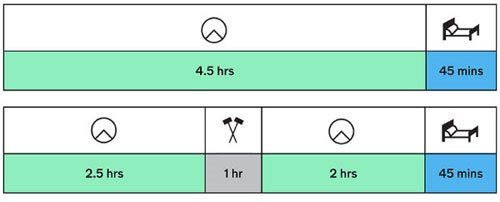
A break is any period during which a driver may not carry out any driving or any other work and which is used exclusively for recuperation. A break may be taken in a moving vehicle, provided no other work is undertaken.
Alternatively, a full 45-minute break can be replaced by one break of at least 15 minutes followed by another break of at least 30 minutes. These breaks must be distributed over the 4.5 hour period. Breaks of less than 15 minutes will not contribute towards a qualifying break, but neither will they be counted as a duty or driving time. The EU rules will only allow a split-break pattern that shows the second period of the break being at least 30 minutes, such as in the following examples:
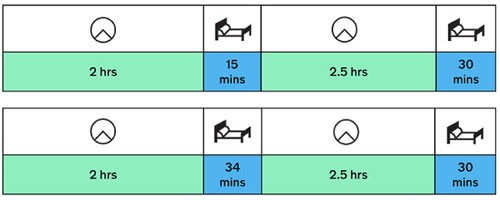

The above split-break pattern is illegal because the second break is less than 30 minutes.
A driver ‘wipes the slate clean if they take a 45-minute break, or qualifying breaks totalling 45 minutes before or at the end of a 4.5 hour driving period. This means that the next 4.5 hour driving period begins with the completion of that qualifying break, and in assessing break requirements for the new 4.5 hour period, no reference is to be made to driving time accumulated before this point. For example:

Breaks may also be required under the separate Road Transport (Working Time) Regulations 2005. See Working Time Rules (WTR) below for further details.
Daily Driving Limit
The maximum daily driving time is 9 hours, for example:
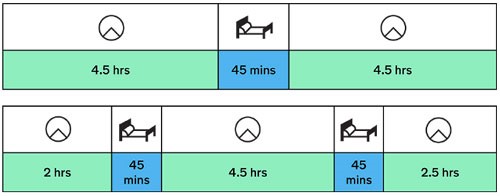
The maximum daily driving time can be increased to 10 hours twice in a fixed week, for example:
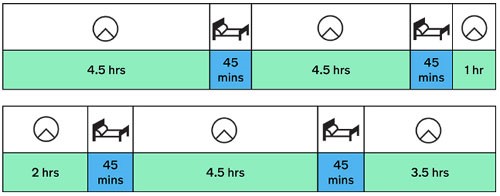
Daily Driving Time
Daily driving time is either:
- The total accumulated driving time between the end of one daily rest period and the beginning of the following daily rest period
- The total accumulated driving time between a daily rest period and a weekly rest period (or vice versa)
All off-road driving between rest periods will also count towards the daily driving limit where there is also driving on the public highway between those same rest periods. Where there is no driving on the public highway between rest periods then any off-road driving is considered to be ‘other work’.
Weekly Driving Limit
The maximum weekly driving limit is 56 hours, which applies to a fixed week.
Fixed Week
A fixed week starts at 00.00 on Monday and ends at 24.00 on the following Sunday.
The following diagram shows an example of how this might be achieved:
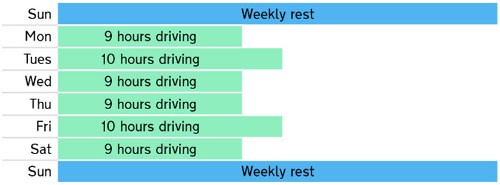
Total weekly hours driving = 56
Two-weekly Driving Limit
The maximum driving time over any two-weekly period is 90 hours; for example:

The following is an example of how a driver’s duties might be organised in compliance with the rules on weekly and two-weekly driving limits:
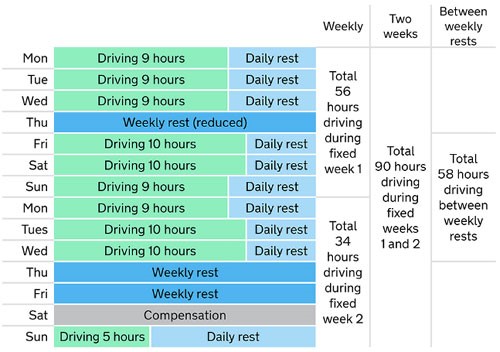
Working Time Rules
The working time rules that apply depend on whether a vehicle is driven in the scope of the EU or GB domestic drivers’ hours’ rules.
Driving under the EU Drivers’ Hours Rules
If you operate a vehicle in the scope of the EU drivers’ hours rules, then you are subject to the Road Transport (Working Time) Regulations 2005 (as amended – ‘the 2005 Regulations’), unless you are an occasional mobile worker (see text boxes at the end of this Annex for definitions).
The main provisions of the 2005 Regulations are as follows:
- Weekly working time must not exceed an average of 48 hours per week over the reference period - a maximum working time of 60 hours can be performed in any single week providing the average 48-hour limit is not exceeded
- Night work: if night work is performed, working time must not exceed 10 hours in any 24-hour period. Night time is the period between 00.00 and 04.00 for goods vehicles and between 01.00 and 05.00 for passenger vehicles. The 10-hour limit may be exceeded if this is permitted under a collective or workforce agreement
- Breaks:
- Mobile workers must not work more than 6 consecutive hours without taking a break
- If your working hours total between 6 and 9 hours, working time should be interrupted by a break or breaks totalling at least 30 minutes
- If your working hours total more than 9 hours, working time should be interrupted by a break or breaks totalling at least 45 minutes
- Breaks should be of at least 15 minutes’ duration
- Rest - the regulations are the same as the EU or AETR drivers’ hour's rules
- Record keeping - records need to be kept for two years after the period in question
The reference period for calculating the 48-hour week is normally 17 weeks, but it can be extended to 26 weeks if this is permitted under a collective or workforce agreement.
There is no ‘opt-out’ for individuals wishing to work longer than an average 48-hour week, but breaks and ‘periods of availability’ do not count as working time.
Generally speaking, a Period of Availability (POA) is a waiting time, the duration of which is known about in advance. Examples of what might count as a POA are; accompanying a vehicle on a ferry crossing or waiting while other workers load/unload the vehicle. For mobile workers driving in a team, a POA would also include time spent sitting next to the driver while the vehicle is in motion unless the mobile worker is taking a break or performing other work such as navigation.
In addition, drivers are affected by two provisions under the Working Time Regulations 1998 (as amended – ‘the 1998 Regulations’). These are:
- An entitlement to 5.6 weeks paid annual leave
- Health checks for night workers
If a driver only occasionally drives vehicles subject to the EU drivers’ hours’ rules, he/she may be able to take advantage of the exemption from the 2005 Regulations for occasional mobile workers (see text box below for the criteria).
Self-employed drivers were brought into the scope of the EU Working Time Directive 2002/15/EC in GB in May 2012, by the Road Transport (Working Time) Amendment Regulations 2012.
DVSA enforces the provisions of the 2005 Regulations and the requirement for health checks for night workers (under the 1998 Regulations).
For further information relating to annual leave, the Advisory, Conciliation and Arbitration Service (ACAS) national helpline can be contacted on 0300 123 1100, for free support and advice.
